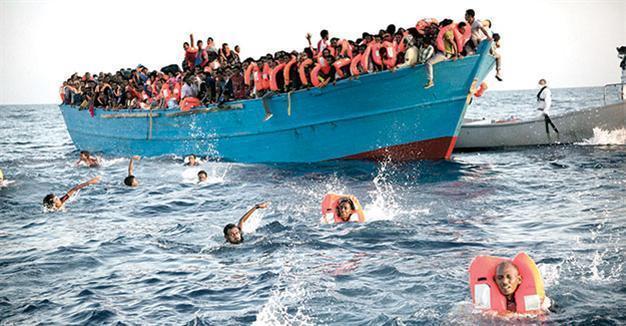Some 6,500 migrants rescued off Libya: coastguard
ROME/ATHENS

Migrants, most of them from Eritrea, jump into the water from a crowded wooden boat as they are helped by members of an NGO during a rescue operation at the Mediterranean sea, about 13 miles north of Sabratha, Libya, Monday, Aug. 29, 2016. g at the zone. AP photo
Around 6,500 migrants were rescued off the coast of Libya on Aug. 29, the Italian coastguard said, in one of its busiest days of life-saving in recent years that came amid a spike in the number of refugees arriving in Greece from Turkey.Dramatic images of one operation showed about 700 migrants crammed onto a fishing boat, with some of them jumping off the vessel in life jackets and swimming toward rescuers.
A five-day-old baby was among those rescued along with other infants and was airlifted to an Italian hospital, according to Doctors Without Borders (MSF), which took part in operations.
“The command center coordinated 40 rescue operations” that included vessels from Italy, humanitarian organizations as well as the EU’s border agency Frontex, saving 6,500 migrants, the coastguard wrote on Twitter.
On Aug. 28 more than 1,100 migrants were rescued in the same area.
The total number of arrivals in Italy this year now stands at 112,500, according to the United Nations’ refugee agency (UNHCR) and the coastguard, slightly below the 116,000 recorded by the same point in 2015.
Almost all of those migrants originate from West Africa and the Horn of Africa, often departing from Libya en masse when the sea is calm and a southern wind can push boats up into international waters.
Such days often come one after another, leading to large numbers of boats over a short period. More than 13,000 people were rescued in under a week at the end of May, and 8,300 more at the start of August.
The Italian coastguard predicted that weather conditions would encourage the departure of further migrant boats on Aug. 30.
The vessels are often flimsy and overcrowded while some of the migrants set off in such poor health that even if the crossing is calm they cannot survive a day at sea.
There are around a dozen vessels run by humanitarian groups that patrol the waters off the Libyan coast, but tensions in the zone have flared recently as rival factions battle to control migrant trafficking.
This month an MSF ship taking part in migrant rescue operations came under attack from armed men who shot at the vessel before briefly climbing aboard, the medical charity said.
Nobody was hurt in the incident, which took place on Aug. 17, the group said.
More than 3,000 migrants have died at sea while trying to reach either Greece or Italy since the start of this year, an increase of some 50 percent on the same period in 2015.
Some 204,000 others crossed the Mediterranean to Europe in the first six months of this year, the U.N. refugee agency said, as the continent battles its worst migration crisis since World War II.
Last year more than 1 million migrants made the journey to Europe, with the majority fleeing war in Syria and the Middle East.
Arrivals to Greek islands jump
More than 460 migrants and refugees arrived on Greek islands from Turkey on Aug. 30, the highest in several weeks, despite a European Union deal with Ankara agreed in March to close off that route.
Greek authorities recorded 462 new arrivals between Aug. 29 and 30, up from 149 the previous day. Most entered through the Aegean islands of Lesbos and Kos.
Daily arrivals fluctuate, ranging from a couple of hundred migrants and refugees a day to just dozens, but indicate a steady inflow five months after the deal with Turkey was agreed. Under the accord, which still hangs by a thread due to a disagreement between Turkey and the EU, those who cross to Greece without documents from March 20 will be sent back to Turkey unless they apply for asylum and their claim is accepted.
The EU has pushed for a change in Turkey’s anti-terror law to agree on visa-free travel for Turks in exchange for the deal, but Turkey has insisted such a change is not possible.
The UNHCR said it recorded a rise in arrivals toward the end of August but it was too early to say if there had been a change in trends.
“So far it doesn’t look like that but we are following the situation very closely,” UNHCR spokesman William Spindler told a U.N. briefing in Geneva.
According to the UNHCR, an average 100 people a day arrived on Greek islands from Turkey in August, up from 60 in July. The International Organization for Migration (IOM) said 2,808 people arrived in Greece through Aug. 28, the largest monthly number since April.
IOM spokesman Joel Millman said the number of arrivals had been climbing in recent weeks and there were also signs of more migrants and refugees leaving Turkey for Bulgaria.
So far under the deal, just 482 people have been deported to Turkey but none had applied for asylum, Greece says. No rejected asylum seekers have been sent back.
















